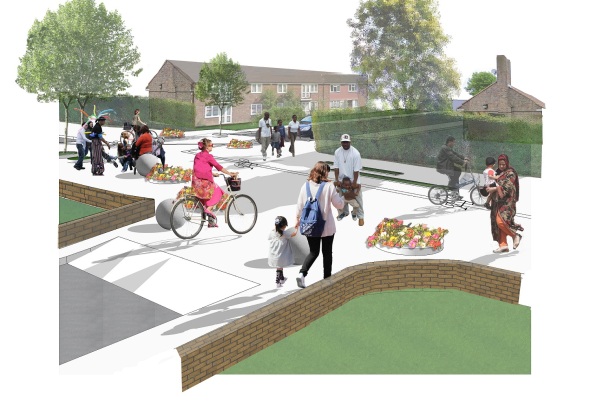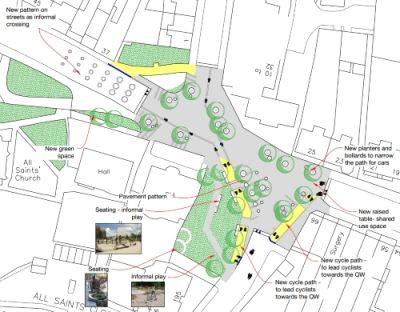There's a lot more going on about traffic management/traffic calming locally than I had realised - in addition to Mini-Holland (rebranded as Cycle Enfield) and the Quieter Neighbourhoods schemes (see this article) In particular two schemes, one in Enfield and one in Haringey, seem relevant.
DIY Streets Edmonton
Enfield are engaged with Sustrans on a "DIY" street scheme which involves Church Street Edmonton between the A10 and Hertford Road. Church Street has similarities to Green Lanes. It includes bus routes and is a busy through route, though the driver (no pun intended) was "to improve the journey to school and to other local amenities and tackle issues affecting their streets and promote more active, sociable communities."
Example of a DIY Streets Edmonton proposal for a junction on the Haselbury Estate (click on the map to enlarge)
 DIY Streets Edmonton Church St-Winchester Road Intersection (click on the map for a larger version)
DIY Streets Edmonton Church St-Winchester Road Intersection (click on the map for a larger version)
The DIY Streets Edmonton website isn't very clear on initial detail, but essentially the project seems to be focused on the shared space, not cycle lane priority, approach. If so, such an approach seems to me to be likely meet a greater range of road user and pedestrian needs in Palmers Green than the initial Mini-holland bid (which was focused on engineered cycle lanes). This would offer particular benefits to residents and the shopping environment.
Download an overall plan of the Church Street proposals (PDF 17MB).
Turnpike Lane/West Green DIY Streets
Sustrans have been working with Haringey Council since 2011 on the Turnpike Lane area. This scheme covers residential streets, none perhaps as busy as Green Lanes in Palmers Green, and with a much more complex road pattern than is covered by the proposed Fox Lane Quieter Neighbourhood. However the approach and outcomes seem to offer particular lessons for the latter.

Turnpike Lane/West Green DIY Project (click to enlarge)
There is an interesting Guardian article about the Turnpike Lane scheme, published in 2012 and headlined "Flowerpots not Bollards". I particularly like the following paragraph:
"Rather than the blunt tools of speed bumps and chicanes, drivers are persuaded that they are now in a residential area through almost unconscious cues, such as patterned blockwork junctions, flowerpots in place of bollards and extended, gently rounded kerbs where pedestrians cross."
The Sustrans website has a page with an outline description of the scheme and the DIY approach.
I haven't caught up with the re-arrangements along Green Lanes from Turnpike Lane to Wood Green tubes, and there may be lessons too from this major scheme for Green Lanes in Enfield.
Lessons for Palmers Green?
If the March 2014 Palmers Green Public Realm consultation process had had time to develop on the Sustrans/DiY Streets consultation model, then we might have avoided the conflict we now face over the perceived negative impact of mini-holland. Is it too late to reconsider how the consultation should now continue?
On a similar theme, will the consultation on Quieter Neighbourhoods allow the same degree of community involvement as DIY streets has at Turnpike Lane and Church Street?
[Article modified on 7 November 2014 by adding additional DIY Streets Edmonton map]


